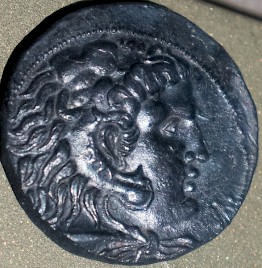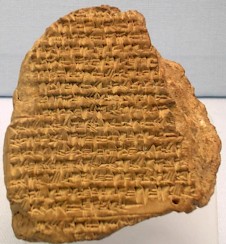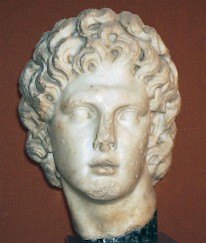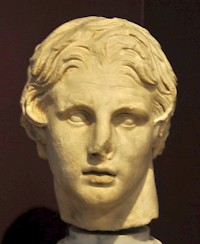Alexander 3.1 Eastern sources
Alexander the Great (*356; r. 336-323): the Macedonian king who defeated his Persian colleague Darius III Codomannus and conquered the Achaemenid Empire. During his campaigns, Alexander visited a.o. Egypt, Babylonia, Persis, Media, Bactria, the Punjab, and the valley of the Indus. In the second half of his reign, he had to find a way to rule his newly conquered countries. Therefore, he made Babylon his capital and introduced the oriental court ceremonial, which caused great tensions with his Macedonian and Greek officers.
Source Criticism

For historians, the distinction between primary, secondary, and tertiary sources is fundamental. A primary source is contemporary with the events it describes: e.g., newspapers, the parliamentary records, diaries, and tape recordings. Primary sources are usually kept in archives and are not what one calls nice reading.
A secondary source is essentially an afterthought of someone who wanted to find out what really happened and has researched the primary sources in the archives. An example is the biography of a king. Publications like these are, depending on the literary qualities of the author, a lot more entertaining, but the reader has to take the writer's word for it that he has used all relevant primary sources. A surprisingly large part of the debates of historians are devoted to accusations of selective use of archival material.
Secondary sources are used to write tertiary sources, which have a larger scope and ignore the details. They are also called syntheses. An example is Syme's The Roman Revolution (1939).
The distinction between primary, secondary and tertiary sources is artificial; there are many works that can be classified in two categories. Nonetheless, the distinction is useful because it offers a tool to establish the relative historical merit of these texts. When a primary and a tertiary source contradict each other, it is better to rely upon the primary source and to explain why the tertiary source has another point of view, than the other way round.
A contemporary source: the Astronomical Diaries

If we ignore a handful of inscriptions and a passing remark by the Athenian orator Aeschines, the only contemporary, primary source on Alexander is the Astronomical Diary that was kept in the Esagila, the temple of the Babylonian supreme god Marduk. It contains a day-by-day account of celestial phenomena, but also mentions other events, such as the level of the Euphrates, meteorological phenomena, food prices, incidents concerning Babylon and its temples, and political events. After all, celestial phenomena were believed to be omens of important political changes.
Those who want to study Alexander the Great have access to four tertiary sources (written in Greek and Latin), many quotes from secondary sources (all written in Greek) and one primary source. It is written in Babylonian and is also interesting because it offers a non-Greek perspective.
Nineteenth- and twentieth-century archaeologists have excavated hundreds of thousands of cuneiform tablets in Mesopotamia and Iran, and it has been impossible to publish them all. As a consequence of this backlog, the Astronomical diary still contains lacunas. Nonetheless, it contains very interesting information, such as the prizes of commodities when Alexander's army was in Babylonian (sky high: the governor of the city had to close the market), an otherwise unknown invasion by Arab tribesmen, and the correct dates of certain events (e.g., Alexander died on 11 June 323 BCE; more...).
The most intriguing information from the Astronomical diary, however, is related to the battle of Gaugamela, which was fought on 1 October 331. It suggests that the Persian soldiers were demoralized and states that they left their king and fled during the battle. This is exactly the opposite of what we read in the four tertiary sources, Diodorus, Curtius Rufus, Plutarch and Arrian: they write that Darius left his soldiers.

The difference is easily explained. The battle was fought on a very dusty plain and it was impossible to see what was going on. At the end of the day, the Macedonians found themselves masters of the field, tried to reconstruct what had happened and assumed that Darius had fled. The official account of the battle was written by Callisthenes of Olynthus (below) and as we will see, the stories of Diodorus, Curtius Rufus, Plutarch, and Arrian are derived from this account. Modern reconstructions of the battle of Gaugamela that ignore the Astronomical diary are therefore nothing but reconstructions of what the Macedonians thought that had happened, and not of the battle itself.
The Astronomical diary is a very important source, and we can be confident that similar sources are waiting to be discovered in the storage rooms of the modern museums. Lack of money, the present political situation in Iraq and the fact that archaeologists and assyriologists belong to different disciplines, are factors that explain why so many cuneiform tablets remain unpublished.
Zoroastrian texts
Even today, the Zoroastrians (that is, the followers of the legendary prophet Zarathustra) tell stories about a serious religious persecution by "the accursed Alexander", who killed the Iranian priests and ordered the holy book of Zoroastrianism, the Avesta, to be burned. One of these sources is the Book of Arda Wiraz, a description of heaven and hell by a religious scholar who wrote commentaries on the Avesta in the third or fourth century of the common era.
This is a very problematic text because it presumes that there were written Zoroastrian texts in the age of Alexander: after all, you cannot burn a copy of the Avesta if it was not a written one. Several modern scholars have argued that in the fourth century BCE, there were no written Avestas, and that religious traditions were transmitted orally. In their view, the writing of the Avesta did not take place before the Sasanian dynasty ruled in Persia, i.e. after 224 CE and probably even later.

In the opinion of the author of this article, this is exaggerated. The texts from the Sasanian age and later additions contain too many statements about the writing of the Avesta in the Achaemenid age to deny the existence of books categorically. The truth may be that in the days of Alexander, the Zoroastrians had a few written texts, and that Alexander has indeed tried to destroy them. (Acceptance of this hypothesis has the additional advantage that it also explains how the Gâthâs have survived, poems from the last quarter of the second millennium BCE that are too well-preserved to be transmitted orally.)
That there were texts that Alexander could destroy, does not mean that oral traditions were not important. Texts like the Book of Arda Wiraz were written long after the events they describe, and contain information that was certainly orally transmitted.
Although oral traditions can be extremely unreliable, it is not wise to ignore them whatsoever. The Jewish Mishnah, a large collection of rabbinical wisdom, offers a splendid parallel. It was written down at the end of the second century CE, long after illustrious Pharisee teachers like Hillel had died. For generations, the teachings of the Pharisees had been transmitted orally. However, no modern scholar has ever claimed that the Mishnah is not a reliable source for the study of Hillel's teachings. The same holds for the Zoroastrian traditions; although they contain anachronisms and miracle stories (like the Mishnah), it is likely that they contain reliable information.
Of course, they are tertiary sources and must be used with caution; nonetheless, they are useful to reconstruct the Persian side of the story, something about which our Greek sources tell us next to nothing.